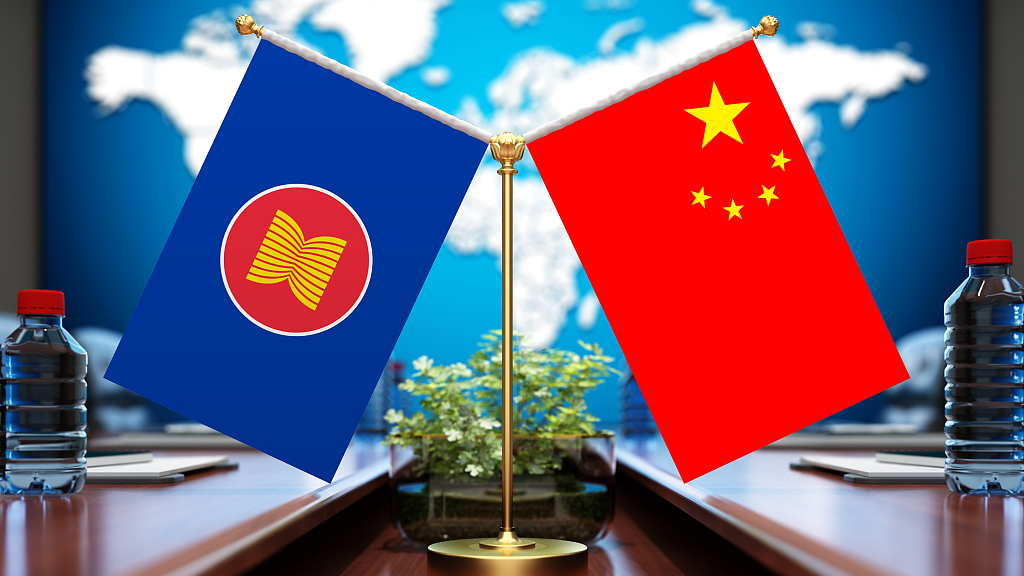
Editor's note: C. Saratchand is a professor at the Department of Economics, Satyawati College at the University of Delhi in India. The article reflects the author's opinions and not necessarily the views of CGTN.
The next summit of the Association of South East Asian Nations (ASEAN) will be held in Cambodia in November 2022. The conference's theme is "Addressing Challenges Together." ASEAN is a complex but durable regional grouping involving countries with diverse economic and political processes. Though ASEAN is a relatively higher income segment of the developing countries, the persistent efforts of the U.S. to unilaterally incorporate the ASEAN countries into the "rules-based international order" has given rise to avoidable conflicts in the region.
The ASEAN member countries occupy various (usually intermediate) stages in global value chains. Such global value chains involve other developing countries including China. A number of commodities are produced in China and elsewhere using inputs, which are produced in ASEAN member countries. Additionally, there are many commodities produced in ASEAN countries such as Vietnam where inputs produced in China and other countries are used.
Apart from these trade linkages involving production, Chinese companies have been steadily increasing their investment in the ASEAN countries and vice versa. Moreover, during the COVID-19 pandemic, there has also been healthcare-related cooperation between ASEAN and China.
In other words, the extent of economic integration and concomitant political dialogue between ASEAN and China has increased both at the multilateral or bilateral levels. The recent set of agreements between Vietnam and China is an indication of this process of integration. It is noteworthy that these bilateral agreements involve both the economic and security domains.
The U.S. has sought to respond to this growing integration between ASEAN and China through a set of measures that is disproportionately based on verbiage rather than substance. Nonetheless, this verbiage provides an ideological cover for Washington's allies when these countries end up compromising their strategic autonomy.
Actually, the U.S. is incapable of functioning as a drop-in replacement for China as a partner of ASEAN since the U.S. economy is no longer predominant in manufacturing in terms of both output and technology. Besides, attempts by the U.S. to exclude China from global value chains are unlikely to make any headway. This will be the case, since such measures are based on a misunderstanding on how global value chains operate in practice.
Even if some production capacity shifts from China to ASEAN, that will not reduce the extent of integration between China and ASEAN, since production units will use inputs produced in China and vice versa. Further, given the steadily rising share of China's economy in the world economy, the extent of integration between ASEAN and China is likely to rise over time.

A view of the 19th China-ASEAN Expo exhibition in Nanning, south China's Guangxi Zhuang Autonomous Region, September 17, 2022. /CFP
A view of the 19th China-ASEAN Expo exhibition in Nanning, south China's Guangxi Zhuang Autonomous Region, September 17, 2022. /CFP
Foreign Minister of Singapore Vivian Balakrishnan has explicitly stated that ASEAN will "refuse to choose" between the U.S. and China. In other words, ASEAN sees its interests are best served in closer integration with all countries including China. Unlike the U.S., China has not asked for ASEAN to forsake its strategic autonomy.
In terms of exercising strategic autonomy, the posture of ASEAN can be contrasted with some allies of the U.S. in Europe. The increasing inability of these allies to prioritize their own interests has led to setbacks not only in terms of their own development trajectories but also international diplomacy. One unfortunate outcome of this strategic pusillanimity is the ongoing conflict in Ukraine.
It is arguable that this divergence between these two sets of countries, namely ASEAN and U.S. allies, is in the first place due to their concrete status in contemporary international political economy. It also derives from the differences in the historical trajectories of these two sets of countries, including the political willingness of ASEAN member countries to foreground their own interests. The recent visit of German Chancellor Olaf Scholz to China is however indicative of the fact that the quest for strategic autonomy has not yet been extinguished even among Washington's European allies.
The development trajectory of China, in the first place, has the potential to advance the strategic autonomy of both developing and developed countries, as well as regional groupings such as ASEAN. After all, an international system that is grounded in the UN charter cannot but be based on the strategic autonomy of UN member countries. The ASEAN summit to be held in November and their dialogues with countries such as China are likely to be a harbinger of the realization of international relations based on strategic autonomy.
(If you want to contribute and have specific expertise, please contact us at opinions@cgtn.com. Follow @thouse_opinions on Twitter to discover the latest commentaries on CGTN Opinion Section.)